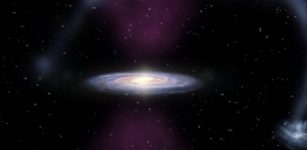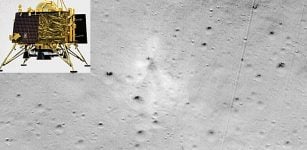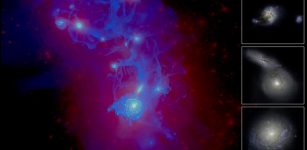The Puzzle Of Stellar Metal Pollution And Hungry White Dwarfs
Eddie Gonzales Jr. – MessageToEagle.com – The phenomenon of stellar metal pollution in white dwarfs has long baffled astronomers.
It is an intriguing enigma that demands study.
Planetesimal orbits around a white dwarf. Initially, every planetesimal has a circular, prograde orbit. The kick forms an eccentric debris disk which with prograde (blue) and retrograde orbits (orange). Credit: Steven Burrows/Madigan Group/JILA
The celestial bodies referred to as white dwarfs possess a remarkable characteristic – they harbor a mass comparable to that of our sun, yet their physical dimensions are akin to the Earth’s. These entities are prevalent in our galaxy, with 97% of stars ultimately transforming into white dwarfs. As stars approach the culmination of their life cycles, their cores undergo a gravitational collapse, condensing into the dense spherical form of a white dwarf.
This phenomenon lends our galaxy an ethereal semblance of a celestial graveyard.
However, astronomers have puzzled over the chemical makeup of these stellar remnants for years. The presence of heavy metal elements—like silicon, magnesium, and calcium—on the surface of many of these compact objects is a perplexing discovery that defies our expectations of stellar behavior.
“We know that if these heavy metals are present on the surface of the white dwarf, the white dwarf is dense enough that these heavy metals should very quickly sink toward the core,” explains JILA graduate student Tatsuya Akiba, in a press release.”
So, you shouldn’t see any metals on the surface of a white dwarf unless the white dwarf is actively eating something.”
While white dwarfs can consume various nearby objects, such as comets or asteroids (known as planetesimals), the intricacies of this process have yet to be fully explored. However, this behavior could hold the key to unraveling the mystery of a white dwarf’s metal composition, potentially leading to exciting revelations about white dwarf dynamics.
The researchers simulated the white dwarf receiving a “natal kick” during its formation (which has been observed) caused by asymmetric mass loss, altering its motion and the dynamics of any surrounding material.
They also examined the white dwarf’s dynamics after 100 million years, and found that the white dwarf’s nearby planetesimals still had elongated orbits and moved as one coherent unit, a result never seen before.
“This is something I think is unique about our theory: we can explain why the accretion events are so long-lasting,” states Madigan . “While other mechanisms may explain an original accretion event, our simulations with the kick show why it still happens hundreds of millions of years later.”
These results explain why the heavy metals are found on the surface of a white dwarf, as that white dwarf continuously consumes smaller objects in its path.
As Madigan’s research group at JILA focuses on gravitational dynamics, looking at the gravity surrounding white dwarfs seemed like a natural focus of study.
“Simulations help us understand the dynamics of different astrophysical objects,” Akiba says. “So, in this simulation, we throw a bunch of asteroids and comets around the white dwarf, which is significantly bigger, and see how the simulation evolves and which of these asteroids and comets the white dwarf eats.”
As Akiba elaborates, “Other studies have suggested that asteroids and comets, the small bodies, might not be the only source of metal pollution on the white dwarf’s surface. So, the white dwarfs might eat something bigger, like a planet.”
The discoveries illuminate the origin and future evolutionary trajectory of our solar system, with details about the underlying chemistry involved.
Madigan asserts, “The vast majority of planets in the universe will ultimately find themselves orbiting a white dwarf.”
“It is plausible that 50% of these systems, including our own solar system, may be consumed by their star. Now, we possess a mechanism to elucidate the rationale behind this phenomenon.”
“Planetesimals can give us insight into other solar systems and planetary compositions beyond where we live in our solar region” McIntyre adds. “White dwarfs aren’t just a lens into the past. They’re also kind of a lens into the future.”
Written by Eddie Gonzales Jr. – MessageToEagle.com Staff Writer
Related Posts
-
 New Atmospheric Phenomenon Has Been Named ‘Steve’ – What Are These Ghostly Lights?
No Comments | Apr 27, 2017
New Atmospheric Phenomenon Has Been Named ‘Steve’ – What Are These Ghostly Lights?
No Comments | Apr 27, 2017 -
 NASA Cargo Launches To Space Station Aboard Orbital ATK Resupply Mission
No Comments | Dec 7, 2015
NASA Cargo Launches To Space Station Aboard Orbital ATK Resupply Mission
No Comments | Dec 7, 2015 -
 Puzzling Massive Ancient Wolfe Disk Shouldn’t Exist – Astronomers Say
No Comments | May 21, 2020
Puzzling Massive Ancient Wolfe Disk Shouldn’t Exist – Astronomers Say
No Comments | May 21, 2020 -
 UCR Astronomers Have Identified 121 Giant Planets That May Harbor Life
No Comments | May 31, 2018
UCR Astronomers Have Identified 121 Giant Planets That May Harbor Life
No Comments | May 31, 2018 -
 Evidence Of Cataclysmic Flare That Exploded 3.5 Million Years Ago
No Comments | Oct 8, 2019
Evidence Of Cataclysmic Flare That Exploded 3.5 Million Years Ago
No Comments | Oct 8, 2019 -
 NASA Finds India’s Vikram Lunar Lander With Help Of A Chennai Engineer
No Comments | Dec 5, 2019
NASA Finds India’s Vikram Lunar Lander With Help Of A Chennai Engineer
No Comments | Dec 5, 2019 -
 How Long Is A Day On Venus? Scientists Crack Mysteries Of Our Closest Neighbor
No Comments | May 1, 2021
How Long Is A Day On Venus? Scientists Crack Mysteries Of Our Closest Neighbor
No Comments | May 1, 2021 -
 10 Billion Year, 50,000 Light-Year Journey To Black Hole
No Comments | Dec 5, 2023
10 Billion Year, 50,000 Light-Year Journey To Black Hole
No Comments | Dec 5, 2023 -
 Black Hole Discovered Firing Jet At Neighbouring Galaxy
No Comments | Oct 13, 2022
Black Hole Discovered Firing Jet At Neighbouring Galaxy
No Comments | Oct 13, 2022 -
 How Disorderly Young Galaxies Grow Up And Mature
No Comments | Sep 3, 2021
How Disorderly Young Galaxies Grow Up And Mature
No Comments | Sep 3, 2021

